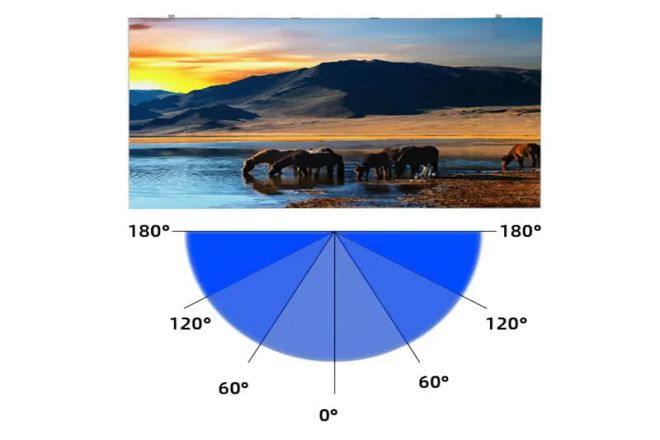介绍
1、LED显示屏的视角有哪些?
LED显示屏的视角主要不是通过“窄视角、中视角、广视角、超广视角”这样的直接分类来定义,而是与其安装环境、用途以及具体的技术参数等更多相关。
不过针对您的分类,我可以尝试按照一般的理解和技术参数范围,对LED显示屏的视角做一个大概的分类:
- 窄视角LED显示屏:
该类显示屏在水平和垂直方向的可视角度都比较小,通常适用于需要控制观看范围或者防止侧偷看的场合,例如机密会议、银行柜台等。
但需要注意的是,并不是所有LED显示屏都有明确的“窄视角”产品,这种分类更多的是基于对应用场景和技术参数的理解,视角可能小于100°。
- 中视角LED显示屏:
这种显示器在视角上介于窄视角和宽视角之间,适合一般商用显示器, 室内活动等场合,能够提供比较均衡的观看体验,可视角度大概在100°到140°之间。
- 广视角LED显示屏:
此类显示屏视角大,可在较大范围内保持图像清晰度和色彩准确度,适合大型活动、户外广告, 体育馆以及其他需要宽阔观众覆盖范围的场合,视角通常大于140°,部分高端产品甚至可以达到160°或更宽。
- 超广视角LED显示屏(又称全景视角、全视角等):
这类显示屏在技术上追求极致的可视角度,力求在任何角度都能提供出色的观看效果。不过需要注意的是,“超广视角”并不是一个严格的技术标准或分类,而是对可视角度极大的产品的描述。
可视角度已接近甚至超过180°,但需要注意的是,由于LED显示屏的物理结构和光学特性,实现真正的360°全视角仍是一个技术挑战。
2. 如何测量LED显示屏的视角

想象一下,你站在一块 LED 显示屏前,它正在播放一些明亮的图像或视频。现在,你想知道在什么角度范围内,显示屏仍能保持清晰明亮。这就是我们要测量的“视角”。
1). 测量视角的基本步骤:
- 选择颜色:
首先,将显示器设置为只显示一种颜色(例如纯红、纯绿或纯蓝),并将亮度调到最高。这是因为我们要分别测量每种颜色的视角。
- 找到中心点:
确定显示屏上的中心点,例如屏幕的中间。此点将是我们测量的起点。
- 测量水平视角:
站在显示器前面,使用一种叫做“亮度计”或“色彩分析仪”的工具来测量中心点的亮度。
然后,你慢慢向左移动,同时观察亮度计上的读数。当亮度降至原来的一半时,停下来,记下你当前位置与中心点之间的角度。这就是向左的水平视角。
接下来你回到中心点并向右移动,重复上述步骤,使水平视角向右移动。
最后以两个角度中较小的一个作为显示器的水平视角。
- 测量垂直视角:
此步骤与测量水平视角非常相似,但您上下移动而不是左右移动。同样,您需要找到亮度降至一半的位置并记下角度。上下测量,然后取较小的角度作为垂直视角。
2).注意事项:
环境光:尽量在较暗的环境中测量,因为太亮的环境光可能会影响测量结果。
工具精度:所使用的亮度计或色彩分析仪必须准确可靠,以便获得准确的测量结果。
多次测量:为了提高准确性,可以测量几次,然后取平均值。
3、影响LED显示屏视角的因素分析
影响LED显示屏视角的因素有很多,它们共同决定了显示屏在不同角度下的观看效果。下面就LED芯片特性、封装技术、显示模组设计、控制系统与驱动四个方面进行详细分析:

- LED芯片特性
LED芯片的视角是决定LED显示屏视角的重要因素之一,LED芯片的视角是指LED发光时,光分布的角度范围。
不同视角的LED芯片适用于不同的应用场景,例如户外显示屏大多采用水平视角为100°、垂直视角为50°的椭圆LED,以保证在更大范围内看到清晰的图像;而室内显示屏则可能采用水平和垂直视角均为120°的贴片LED,以提供更宽的视角。
另外,LED芯片的亮度也是影响视角的一个因素,因为高亮度的LED芯片可以在一定程度上弥补视角减小造成的亮度损失。
- 封装技术
封装技术对LED显示屏的视角有着直接的影响,不同的封装方式会造成LED芯片发出的光线散射的角度不同,从而影响显示屏的视角。
例如,封装有 贴片机 (表面贴装技术)通常具有更宽的视角,因为它们可以更有效地控制光的散射方向。此外,封装材料的透光率和散热性能也会影响LED显示屏的视角和整体性能。

- 显示模块设计
显示屏模组的设计也是影响LED显示屏视角的关键因素之一,模组内LED灯珠的排列方式、间距大小以及模组间的拼接方式都会影响显示屏的视角。
灯珠的合理排列及间距,可以保证不同角度光线分布均匀,提高显示屏的可视角度。
同时,模组之间的拼接精度也会影响显示屏的整体视角,如果拼接不均匀或者存在缝隙,就有可能造成光线在这些区域发生散射或者反射,从而降低显示屏的视角。
- 控制系统及驱动
控制系统与驱动虽然不直接决定LED显示屏的视角,但却对显示屏的显示效果、稳定性有重要的影响,并间接影响观众的观看感受。
控制系统负责接收外部信号并将其转换成驱动电路能够理解的指令,从而控制LED显示屏的亮度、颜色等参数。优质的控制系统和驱动电路可以保证显示屏在不同角度下都能保持稳定的显示效果和色彩还原。
此外,控制系统还可以通过调节LED芯片的亮度来平衡观看角度和亮度的关系,以达到最佳观看效果。
4、优化LED显示屏视角的步骤

LED显示屏视角优化的步骤是一个综合的过程,涉及到很多方面的调整和改进。
1).优化LED芯片及封装。
选择高视角LED芯片:根据实际需要,选择视角更宽的LED芯片,如水平和垂直角度都在120°以上的芯片。
改善封装技术:采用先进的封装技术,如透镜封装等,改善LED芯片的光散射方向,增大视角。
2).调整显示模块设计。
优化灯珠排列:调整模组内LED灯珠排列方式,使配光更加均匀,提高视角一致性。
减小灯珠距离:在不影响散热和成本的前提下,适当减小灯珠距离,以增加单位面积的像素密度,从而改善视角效果。
改善组件拼接:保证组件间拼接的平整度及精度,避免因拼接不均匀而引起的光散射、反射问题。
3).调整控制系统及驱动装置。
优化驱动电路:根据显示屏的实际需求和特点,调整驱动电路的参数,保证LED芯片在不同角度下都能获得稳定的电流、电压供应。
升级控制系统:采用先进的控制系统,提高信号的传输速度和稳定性,减少由于信号传输问题造成的视角损失。
4).应用视角优化技术。
使用视角优化膜:
将视角优化膜贴合于显示屏表面,通过改变光的传播路径和分布特性,改善显示屏的视角和色彩一致性。
该视角优化膜可以使不同颜色的LED灯的视角分布均匀,消除左右视角差异及不同像素间的视角差异。
调整显示内容:
根据显示屏的特性和观看角度,调整显示内容的亮度、对比度、色彩等参数,以获得更好的视觉效果。
结论
通过本文的探讨不难发现,LED显示屏视角优化是一个涉及技术、设计、应用等多个层面的综合课题,不仅涉及硬件的升级改造,更需要对应用场景的深刻理解和精准把握。
最后,如果您想了解更多关于LED显示屏的知识, 请与我们联系。

